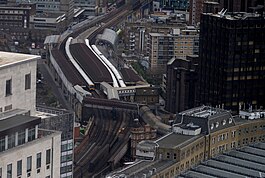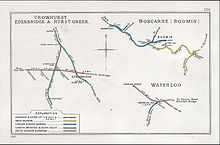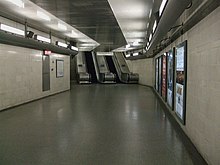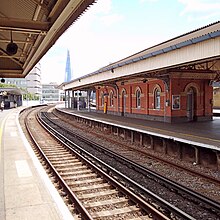| Waterloo East | |
|---|---|
| London Waterloo East | |
 Waterloo East viewed from the London Eye Waterloo East viewed from the London Eye | |
 | |
| Location | Waterloo |
| Local authority | London Borough of Lambeth |
| Grid reference | TQ313800 |
| Managed by | Southeastern |
| Owner | Network Rail |
| Station code(s) | WAE |
| DfT category | B |
| Number of platforms | 4 (lettered A–D) |
| Fare zone | 1 |
| OSI | Waterloo Waterloo Embankment Southwark |
| National Rail annual entry and exit | |
| 2019–20 | |
| – interchange | |
| 2020–21 | |
| – interchange | |
| 2021–22 | |
| – interchange | |
| 2022–23 | |
| – interchange | |
| 2023–24 | |
| – interchange | |
| Railway companies | |
| Original company | South Eastern Railway |
| Pre-grouping | South Eastern and Chatham Railway |
| Post-grouping | Southern Railway |
| Key dates | |
| 1 January 1869 (1869-01-01) | Opened as Waterloo Junction |
| 7 July 1935 | Renamed Waterloo |
| 2 May 1977 | Renamed Waterloo East |
| Other information | |
| External links | |
| Coordinates | 51°30′13″N 0°06′40″W / 51.5037°N 0.111°W / 51.5037; -0.111 |
Waterloo East railway station, also known as London Waterloo East, is a railway station in central London on the line from Charing Cross through to London Bridge towards Kent, in the south-east of England. It is to the east of London Waterloo railway station and close to Southwark tube station.
The station opened in 1869 as Waterloo Junction, to provide a connection between the London and South Western Railway at Waterloo, and the South Eastern Railway at Charing Cross. A dedicated line was built between Waterloo and Waterloo East, which was later converted to a footpath. Trains originally ran to Cannon Street, but after competition from the London Underground, these were withdrawn as a wartime measure in 1916. The station continued to be connected to Waterloo mainline via a footbridge. Waterloo East was given its current name in 1977, and remains an important interchange in London. It is part of the London station group. The station is located in London fare zone 1.
Location

The station is on the South Eastern Main Line 61 chains (1.2 km) down the line from Charing Cross, on the other side of the River Thames across from Hungerford Bridge. Although Waterloo East is a through-station, it is classed for ticketing purposes as a central London terminus.
Services through the station are operated by Southeastern and it is situated within fare zone 1. The main access is via an elevated walkway across Waterloo Road, which connects it to the larger Waterloo station. The eastern ends of the platforms provide pedestrian connection to Southwark station which is served by London Underground's Jubilee line; at street level there is an entrance in Sandell Street. Connections with the Underground's Bakerloo, Northern and Waterloo & City lines are available at Waterloo Underground station.
The four platforms at Waterloo East are lettered rather than numbered to ensure that staff and passengers do not confuse the platforms at the two stations.
London Buses routes 1, 11, 59, 68, 76, 77, 139, 172, 176, 188, 211, 243, 341, 381, C10, peak hours express route SL6 and night routes N1, N68, N171, N343 and N381 serve the station.
History
South Eastern Railway

The station was built by the South Eastern Railway (SER) after the line to Charing Cross opened in 1864. The company were under pressure to connect with London and South Western Railway (LSWR) services, as it would allow the latter to connect to the City of London via Cannon Street. The LSWR were not interested in making Charing Cross a joint station, but were amenable to providing a connection with the SER next to Waterloo.
In 1867, the two companies agreed to build a joint connection so that passengers could change from LSWR to SER services in order to reach the City of London via Cannon Street. Another station, Blackfriars was built to the east, but it was closed in favour of a connecting station with the LSWR. Construction of a single-line, 5-chain (100 m) connection begun in May 1868, and the new connection station opened on 1 January 1869 at a total cost of £14,290 (£1,667,000 as of 2023). Blackfriars station closed on the same date. Trains began running from Waterloo Junction to Charing Cross and Cannon Street around every five minutes. Queen Victoria used the connection for royal trains travelling from Windsor Castle to Dover and Continental Europe.
The original station was built with two platforms, which were 530 feet (160 m) and 440 feet (130 m) long, and both 18 feet (5.5 m) wide. The waiting room and ticket offices were housed in arches underneath the line. The bridge connection from the main Waterloo station included a movable platform, which allowed passengers to cross directly into Waterloo East when trains were not running. It was mounted on a four-wheel truck which could easily be moved out of the way if a train needed to come through. The connection ran until January 1893, when it was discontinued because of overcrowding.
When the SER line opened between Charing Cross and Cannon Street in 1864, it was frequented by prostitutes, who discovered the journey between the two stations was sufficiently long to service clients while paying minimum rent. After Waterloo East opened, the frequent stopping of trains there made this impractical.
The connection from Waterloo Junction through to Cannon Street did not prove a success because of competition from the Metropolitan District Railway (now the District line) and the spread of the Underground. Passengers were generally unaware of the existence of the station, as it was not obvious to find it from the main concourse in Waterloo. Following the opening of the Waterloo and City line on 8 August 1898, connections to Cannon Street were reduced. Cross train services from Waterloo Junction to Cannon Street ended on 31 December 1916, as a wartime economy measure.
The dedicated line from Waterloo through to Waterloo Junction was demolished in 1911 when the main-line station underwent an extensive reconstruction. The bridge which carried the line over Waterloo Road subsequently accommodated the pedestrian walkway between the two stations.
Southern Railway and later

The Southern Railway renamed the station Waterloo (also known as Waterloo Eastern) on 7 July 1935 and it took its present name on 2 May 1977. The platforms were designated A – D at the same time.
The pedestrian access from Waterloo mainline was replaced by the current high level covered walkway in 1992. The site of the original rail link, which had been out of use since 1916 was then demolished.
Waterloo East was closed for maintenance on 24 July 1993 so a link with Southwark tube station, then under construction, could be built. It re-opened on 16 August. Southwark tube station opened on 20 November 1999 with the extension of the Jubilee line to Stratford, and included a direct connection to Waterloo East.
In 2012, ticket barriers were installed at the Sandell Street and Southwark station entrances, and also at the main entrance from Waterloo station following the completion of the retail balcony. In 2018, Transport for London announced a new entrance would be built on Greet Street, providing access to both Waterloo East and Southwark.
Services
| Mainline railways around the South Bank | ||||||||||||||||||||||||||||||||||||||||||||||||||||||||||||||||||||||||||||||||||||||||||||||||||||
|---|---|---|---|---|---|---|---|---|---|---|---|---|---|---|---|---|---|---|---|---|---|---|---|---|---|---|---|---|---|---|---|---|---|---|---|---|---|---|---|---|---|---|---|---|---|---|---|---|---|---|---|---|---|---|---|---|---|---|---|---|---|---|---|---|---|---|---|---|---|---|---|---|---|---|---|---|---|---|---|---|---|---|---|---|---|---|---|---|---|---|---|---|---|---|---|---|---|---|---|---|
| Legend | ||||||||||||||||||||||||||||||||||||||||||||||||||||||||||||||||||||||||||||||||||||||||||||||||||||
| ||||||||||||||||||||||||||||||||||||||||||||||||||||||||||||||||||||||||||||||||||||||||||||||||||||
All "up" trains run to Charing Cross only, and depart from platforms B and D. All "down" trains run from platforms A and C.
All services at Waterloo East are operated by Southeastern using Class 375, 376, 465, 466 and 707 EMUs.
The typical off-peak service in trains per hour is:
- 16 tph to London Charing Cross
- 4 tph to Dartford via Sidcup of which 2 continue to Gravesend
- 1 tph to Dartford via Bexleyheath
- 4 tph to Hayes via Catford Bridge
- 2 tph to Sevenoaks via Grove Park
- 1 tph to Dover Priory
- 1 tph to Ramsgate via Canterbury West
- 2 tph to Hastings via Tunbridge Wells (1 semi-fast, 1 stopping)
- 1 tph to Maidstone East via Swanley


| Preceding station | Following station | |||
|---|---|---|---|---|
| London Charing Cross | SoutheasternSouth Eastern Main Line | London Bridge | ||
| Historical railways | ||||
| Terminus | South Eastern Railway South Eastern Main Line |
Blackfriars | ||
Incidents
On 25 October 1913, a passenger train coming into Waterloo Junction from Blackheath collided with a stationary train in heavy fog. Three people were killed and 24 injured. An inquest was held, where it was determined that the accident was caused by negligence of a signalman, though not to the level of criminal negligence.
Notes
- The Thameslink platforms at St Pancras International and the platforms at New Cross use this numbering convention, as did the platforms at the predecessor Thameslink station to St Pancras, King's Cross Thameslink.
References
Citations
- "Out of Station Interchanges" (XLSX). Transport for London. 16 June 2020. Retrieved 5 November 2020.
- ^ "Estimates of station usage". Rail statistics. Office of Rail Regulation. Please note: Some methodology may vary year on year.
- "Station facilities for London Waterloo East". National Rail Enquiries. Retrieved 29 May 2013.
- Yonge 2008, map 3A.
- "Travelling to, from and via London". National Rail Enquiries. Retrieved 13 December 2018.
- "Where Do London's Mysterious Overhead Footbridges Go?". Londonist. 3 February 2017. Retrieved 11 April 2018.
- ^ Binney, Marcus (2 March 1999). "Sights at the end of the tunnel". The Times. London. p. 18. Retrieved 23 September 2018.
- "Standard Tube Map". Transport for London. Retrieved 24 September 2018.
- Jefferson, Ed (3 August 2016). "From Platform 0 to Platform 9¾: The strange world of British Rail mathematics". CityMetric. Archived from the original on 26 September 2020. Retrieved 21 September 2018.
- "Buses from Waterloo" (PDF). TfL. 15 June 2019. Archived from the original (PDF) on 28 May 2022. Retrieved 1 June 2020.
- "Night buses from Waterloo" (PDF). TfL. 15 June 2019. Archived from the original (PDF) on 30 August 2021. Retrieved 1 June 2020.
- ^ Jackson 1984, pp. 216–217.
- Gray 1990, p. 111.
- Gray 1990, p. 119.
- Jackson 1984, p. 244.
- Gray 1990, pp. 119–120.
- Jackson 1984, pp. 216–217, 244.
- "Sleeping Cars from Calais to Brindisi". The Times. London. 3 June 1879. p. 13. Retrieved 21 September 2018.
- ^ "The Waterloo Link". London Reconnections. 4 January 2011. Retrieved 25 September 2018.
- "New Station At Waterloo Junction". The Times. London. 1 January 1869. p. 9. Retrieved 21 September 2018.
- Maggs 2016, p. 104.
- Jackson 1984, p. 176.
- Gray 1990, p. 120.
- "Some Little-Known Railway Stations". The Railway Magazine. 8: 122–123. 1901.
- Gray 1990, p. 124.
- Maggs 2017, p. 131.
- Jackson 1984, p. 224.
- ^ Christopher 2015, p. 153.
- ^ Butt 1995, p. 242.
- Jackson 1984, p. 362.
- "Waterloo East Pedestrian Link" (Document). Channel Connection. 1992. p. 4.
- Slade 2016, p. 126.
- Hughes, Simon (18 May 1992). "Jubilee Line Extension". Hansard. Retrieved 19 April 2018.
- Day & Reed 2010, p. 207.
- "Waterloo Station's New 220m Balcony Opens to Reduce Congestion in Time for Olympic Games". Network Rail. 17 July 2012.
- "Southwark Tube station could get second entrance to "help ease overcrowding"". London Evening Standard. 12 September 2018. Retrieved 24 September 2018.
- "London Waterloo East". South Eastern Railway. Retrieved 24 September 2018.
- Table 199, 200, 201, 203, 204, 206, 207, 212 National Rail timetable, May 2023
- Pringle, Major J. W. (16 November 1913). "Accident Returns: Extract for the Accident at Waterloo Junction on 25th October 1913". The Railways Archive. Board of Trade. Retrieved 27 September 2024.
- "Another Railway Accident". The Times. London. 27 October 1913. p. 9+. Retrieved 21 September 2018.
- "The London Railway Accident". The Times. London. 4 November 1913. p. 4. Retrieved 21 September 2018.
Sources
- Butt, R. V. J. (October 1995). The Directory of Railway Stations: details every public and private passenger station, halt, platform and stopping place, past and present (1st ed.). Sparkford: Patrick Stephens Ltd. ISBN 978-1-85260-508-7. OCLC 60251199. OL 11956311M.
- Christopher, John (2015). Waterloo Station Through Time Revised Edition. Amberley Publishing. ISBN 978-1-445-65086-9.
- Day, John R; Reed, John (2010) . The Story of London's Underground. Capital Transport. ISBN 978-1-85414-341-9.
- Gray, Adrian (1990). South Eastern Railway. Middleton Press. ISBN 978-0-906520-85-7.
- Jackson, Alan (1984) . London's Termini (New Revised ed.). London: David & Charles. ISBN 0-330-02747-6.
- Maggs, Colin (2016). Maggs's Railway Curiosities. Amberley Publishing. ISBN 978-1-445-65266-5.
- Maggs, Colin (2017). A History of the Southern Railway. Amberley Publishing. ISBN 978-1-4456-5271-9.
- Slade, Ron (2016). Sketching for Engineers and Architects. Routledge. ISBN 978-1-317-40718-8.
- Yonge, John (November 2008) . Jacobs, Gerald (ed.). Railway Track Diagrams 5: Southern & TfL (3rd ed.). Bradford on Avon: Trackmaps. ISBN 978-0-9549866-4-3.
External links
- Train times and station information for Waterloo East railway station from National Rail
| Major railway stations in Great Britain | |||||||||||||
|---|---|---|---|---|---|---|---|---|---|---|---|---|---|
| |||||||||||||
| |||||||||||||
| Thameslink, Great Northern, Southern and Southeastern routes | |||||||||||||||||
|---|---|---|---|---|---|---|---|---|---|---|---|---|---|---|---|---|---|
| |||||||||||||||||
| Stations in italics are served on limited occasions, at peak hours or on Sundays only. | |||||||||||||||||
- Rail transport stations in London fare zone 1
- DfT Category B stations
- Railway stations in the London Borough of Lambeth
- Former South Eastern Railway (UK) stations
- Railway stations in Great Britain opened in 1869
- Railway stations served by Southeastern
- 1869 establishments in England
- Railway termini in London
- London station group